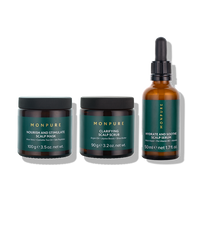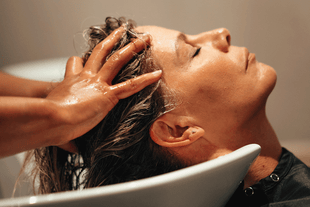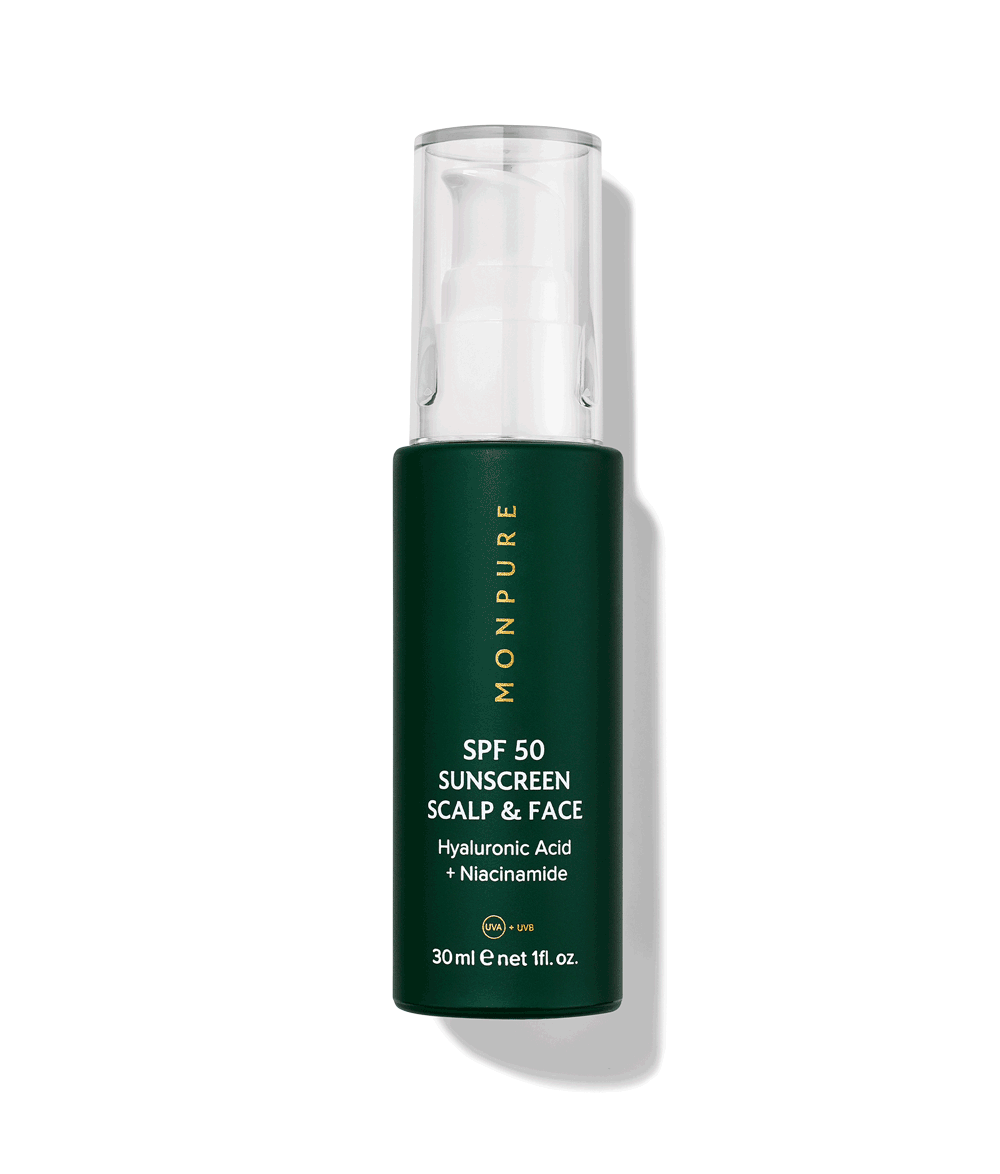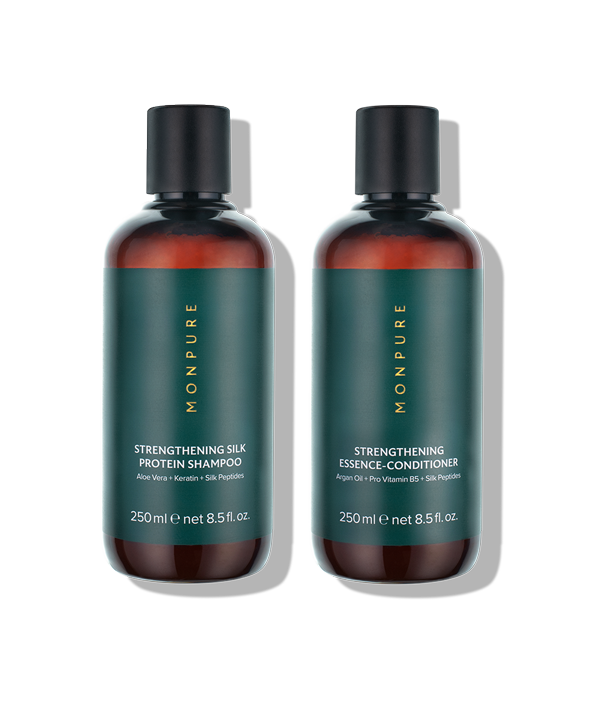Have you ever wondered ‘how does hair grow?’. You may be striving to grow out your hair, rebuild its natural strength after hair loss or get to the bottom of how to harness your natural hair growth cycle to achieve your growth goals for the new year.
Hair on the scalp grows about 1cm per month in healthy individuals. Just like skin cells, our hair undergoes a cycle of growth, transition, rest and renewal. At any given time, hairs will independently cycle through one of three stages of growth: anagen, catagen, and telogen.
Most people notice that over our lifetime, our hair and scalp can transform. Hair thinning, hair loss or changes in hair density over certain periods in our lifetime such as pregnancy, menopause or bouts of stress are part and parcel of the natural life cycle. However, with the right scientifically-grounded ingredients and solutions, the hair growth cycle can be harnessed and strengthened to cultivate optimum hair growth in the face of many disruptions and challenges we face throughout our lives.
The Origins of Hair
Did you know that by week 22 of pregnancy, the developing foetus has already formed all of its hair follicles. New follicles don't form after birth, so babies are born with all the hair follicles they'll ever have. The hair follicle, made up of the dermal papilla and the bulb, is a small organ found in the epidermis layer of the skin that anchors the hair into the scalp. Hair strands grow from the bottom of the follicle, out of the skin and reach the surface of the scalp.
The hair strand itself is the visible hair that grows from the follicle and is made up of three layers, the cuticle, the cortex and the medulla. With this in mind, it is essential that we look after our hair follicles, keeping them activated and healthy, as no ones will be created in our lifetime.
What Are the 3 Stages of Hair Growth?
Unlike other mammals, human hair growth and shedding is random and not seasonal or cyclical. At any given time, a random number of hairs will be in one of three stages of growth and shedding: anagen, catagen, and telogen.
Anagen Phase
The anagen phase is the active or growth phase of the hair growth cycle. It is marked by the rapid division and differentiation of cells in the lower portion of the hair follicle and by the lengthening of the hair strand. In healthy individuals, about 90% of hairs are in the anagen phase at any given time. During this phase the hair grows about 1cm every 28 days. The anagen phase of the hair growth cycle typically lasts between two to six years.
Catagen Phase
The catagen phase is the transition phase of the hair growth cycle. This phase usually lasts between ten and twelve days, during which the follicle shrinks and active hair growth stops. The hair also separates from the bottom of the hair follicle, yet remains in place during this transition. About 3% of hairs are in the catagen phase at any time.
Telogen Phase
The telogen phase is the resting phase of the hair growth cycle. During this phase, the hair cannot grow and eventually sheds from the scalp. The telogen phase typically lasts around three months. Generally, 10 to 15% of hairs are in the telogen phase. The telogen phase is also marked by new hairs that start to form in the follicles that have just released hairs during the catagen phase.
It is essential that each hair follicle, and its surrounding scalp skin, is healthy, nourished, clean and hydrated to support the hair growth cycle. Follicles and scalp-skin that are blocked by sebum, dandruff, dead skin cells, product build-up hinder the quality of hair growth. Obstructed follicles in cases of inflammation, dryness, itchy scalp or malnourishment are also doing to face impeded growth. At MONPURE, we understand that healthy hair starts with a healthy scalp, and we formulate each of our products with this as our central goal.
What Disrupts the Hair Growth Cycle?
Hair loss and hair thinning may occur when the hair growth cycle is disrupted and the anagen phase is shortened, or the telogen phase is lengthened. This can be triggered by a variety of factors, including hormonal fluctuations, improper nutrition, stress and inflammatory scalp conditions.
Hormones
For example, after giving birth, it is normal to notice increased amounts of hair loss postpartum - as all the hairs that remained in the prolonged anagen (growth) phase transition into the catagen phase rapidly. This is accounted for by the sudden decline in oestrogen levels after delivery. At the time, hair loss appears abundant but only represents the elimination of the additional hairs that had been maintained in the anagen phase during pregnancy when oestrogen was soaring.
Similarly, during perimenopause and menopause, many women experience hair thinning as a result of hormonal changes that lead to a disrupted hair growth cycle. As women reach menopausal age, oestrogen and progesterone decrease, while the presence of DHT increases in comparison. DHT affects the hair by shortening the anagen phase of the hair growth cycle, while also lengthening the time between the telogen and new anagen phase. DHT is primarily responsible for follicular miniaturisation, in which the hair follicle shrinks, producing a shorter and thinner hair strand.
Nutrition
The hair growth cycle can also be disrupted by changes in nutrition. For example, research shows that Vitamin D plays an important role in the hair growth cycle. Vitamin D is metabolised by keratin cells, the protein that makes up our hair and scalp skin. A deficiency can interfere with keratin production, resulting in fewer follicles being created and hair growth being inhibited. A deficiency in Vitamin D disrupts this essential process, leading to stunted hair growth and thinning.
Scalp Health
The role of the scalp as an incubatory environment for the preemergent hair strand has a significant impact on hair growth and ultimately, hair loss. Oxidative stress on the scalp, for example, can lead to the progressive damage of cellular structures that support the hair growth cycle. Research suggests that oxidative stress damages the health of the scalp which impedes hair formation and growth. Oxidative stress impacts the anchoring force of the hair strand within the follicle. This is shown by the higher number of hairs in the catagen and telogen phases of the hair growth cycle among people with scalp conditions such as dandruff, seborrheic dermatitis and psoriasis.
Oxidative stress is a key factor in a number of dermatological scalp conditions, including dandruff, seborrheic dermatitis, psoriasis and atopic dermatitis. Therefore, the scalp appears to be impacted by oxidative stress prior to the emergence of the hair. The yeast species Malassezia, which is linked to the conditions dandruff and seborrheic dermatitis, has also been recognised as a source of oxidative stress and is considered to contribute to compromised hair health and growth.
The Nourish and Stimulate Scalp Mask delivers an instant dose of antioxidants and essential vitamins to the scalp and follicles, working to neutralise the effects of oxidative stress. The mask’s hero ingredient, camellia tea oil, is rich in Vitamins A, B, D and E, which are remarkable antioxidants that prevent conditions impacted by oxidative stress.
How to Boost the Hair Growth Cycle
In order to cultivate optimum hair growth, the hair needs to remain in the anagen phase for as long as possible and prolonged dormancy needs to be prevented. This can be supported by a healthy diet and lifestyle, as well as using products that hone in on the source and minimise hair loss by targeting the hair growth cycle itself.
The Follicle Boost Hair Density Serum initially targets the catagen and telogen phases of the hair growth cycle within the first 4-6 weeks, working to minimise excess shedding. Similarly, it boosts the growth of new follicles leaving the telogen phase and entering into a new cycle of the anagen phase, which usually takes around 12-14 weeks. The average hair’s growth rate is around 1cm a month. With this in mind, visible changes in new growth are likely to manifest around 6 months.
The product’s star ingredient, pumpkin seed extract, is a gentle yet effective ingredient that has been scientifically proven to block the 5-alpha reductase enzyme that produces DHT, a byproduct of testosterone that causes hair loss. Specially, DHT shrinks the follicle’s anagen phase and prolongs its telogen phase. Therefore, by blocking the production and minimising the presence of DHT in the bloodstream and on the scalp, the healthy hair growth cycle is supported and excess thinning is prevented. This powerful extract also stimulates follicles, delivers nutrients and boosts circulation to the scalp.
Recent research has demonstrated that topical pumpkin seed oil improves hair growth by 40% over the course of 24 weeks. A recent study has also demonstrated the clinical efficacy of pumpkin seed oil in the treatment of female pattern hair loss (FPHL) and compared its effects with minoxidil 5% foam. The study illustrated that pumpkin seed oil is a rich source of unsaturated fatty acids, especially oleic acid and linoleic acid. Such essential acids are reported to inhibit 5-alpha reductase and in turn, DHT, and therefore contribute to hair growth via their anti-androgen effects.
The Follicle Boost Hair Density Serum is also formulated with skincare-staples retinol and lactic acid, that gently decongest clogged hair follicles, promote healthy cell renewal and enhance the absorption of other ingredients and nutrients, all of which support the hair growth cycle and the incubatory environment of the hair follicles.
It also contains coffee arabica extract, an essential oil proven to offset the effects of DHT through shaft elongation and thickening. What’s more, it’s packed with antioxidants and antimicrobial properties that deliver nutrients and ward off dandruff. It is also formulated with rosemary oil, which promotes cell turnover, boosts circulation and delivers nutrients and oxygen to the follicles.
What Does New Hair Growth Look Like?
Because the growth of new hair functions according to the natural hair growth cycle, it takes time, patience and dedication, as well as consistently using products such as the Follicle Boost Hair Density Serum.
You may initially begin to notice short, baby hairs sprouting when your hair is growing. These new baby hairs differ from tiny flyaways and breakage. Baby hairs tend to be similar in length and are typically soft to the touch, while breakage may be uneven in length, usually having split or fractured ends, and can feel dry or rough to the touch.
If you don’t notice any noticeable changes and growth right away, don’t give up on your hair growth journey. It is important to approach this journey with well-managed expectations, with the understanding that healthy hair growth requires patience and consistency, as it forms part of the broader hair growth cycle.
Frequently Asked Questions
What are signs of new hair growth?
Short, soft “baby hairs” with similar lengths sprout before longer hairs emerge. Patience is required.
Does body hair follow the same cycle?
Yes, body hair like eyebrows and lashes also follow anagen/catagen/telogen phases at various rates. Proper nutrition and hair care support the body’s hair lifecycle.
How to speed up hair growth?
While genetics dictate growth rates, maintaining scalp health, avoiding damage, eating nutrient-rich foods, staying hydrated and managing stress can help optimize hair’s natural cycle.
At what age do you stop getting new hair?
Hair follicles form by birth, not after. While age eventually slows production, follicle stems cells remain present for new hair. Proper care preserves these cells’ functioning.

















